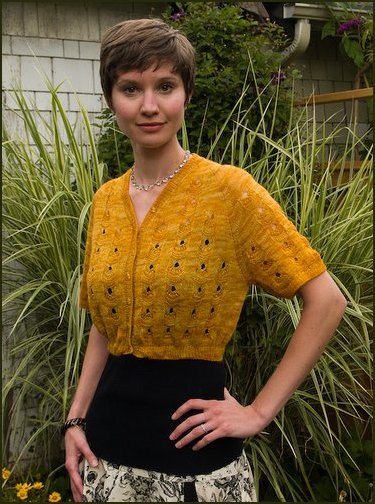 Long a fan of the vintage look (my own bookshelves groan under the weight of vintage knitting titles, usually snagged for a song at boot sales and used bookshops) I was delighted to discover this month PopKnits, an entire online magazine of free, vintage-inspired knitwear patterns. I spent several happy hours perusing the site, and found much to like about this newest offering in the world of online knitting magazines.
Long a fan of the vintage look (my own bookshelves groan under the weight of vintage knitting titles, usually snagged for a song at boot sales and used bookshops) I was delighted to discover this month PopKnits, an entire online magazine of free, vintage-inspired knitwear patterns. I spent several happy hours perusing the site, and found much to like about this newest offering in the world of online knitting magazines.
The trouble of course with vintage knitting patterns is that they’re not very easy to use. As much as I love my vintage knitting book collection, and with the best will in the world, I have found patterns for vintage knitwear usable only as a jumping off point for my own design work. A showcase for vintage styling, PopKnits also hopes to demystify the process of knitting from vintage patterns. Reading Cindy Moore’s article, Rewriting Vintage Patterns, in the Winter issue of PopKnits, helps simplify the process of charting vintage lace designs. I look forward to reading future articles that might help me make better use of the vintage pattern books in my collection.
Lovers of vintage sweater patterns know that they’re often noted for a gauge that modern knitters find impossibly fine. To achieve a true vintage look, you simply have to put in some serious knitting time. What you achieve for the hours and hours of work involved makes an impossibly fine gauge worth the trouble – a true modern classic; something your own future granddaughter will be delighted to wear. I was delighted to find true vintage styling in many of the patterns in PopKnits.
 I simply adored the Footlights Cardigan, by Sarah Pope, in the magazine’s inaugural issue. Inspired by a vintage sweater the designer inherited from her grandmother, Sarah’s pattern uses lace weight yarn(!) and gets all the details of modern vintage styling right.
I simply adored the Footlights Cardigan, by Sarah Pope, in the magazine’s inaugural issue. Inspired by a vintage sweater the designer inherited from her grandmother, Sarah’s pattern uses lace weight yarn(!) and gets all the details of modern vintage styling right.
Knit from the top down, the V-necked raglan sleeved cardigan features a Shetland shell lace pattern, and thoroughly modern shaping gives ample ease to the garment across the bust. I have long been searching for a pattern to help Liberate My Laceweight, and Footlights is perfect for the job. I can’t wait to get knitting.
Other noteworthy patterns include Cubix, a 1960’s Op Art inspired jacket, Clarissa, a pattern for ladylike lace gloves, and the one-skein-wonder, Fayfay, an openwork scarf knit in that perennial Rowan favorite, Kidsilk Haze.
Beyond the articles and patterns you’d expect in an online magazine, one of my favorite features in PopKnits is the inspired use of external links for each pattern. Each pattern has its own Flickr set of images, and knitters are invited to add PopKnits-specific tags to images of their finished items, and become a part of the Flickr set. While linking images to patterns is available on Ravelry, it’s really nice to see PopKnits integrate resources for people who choose to participate outside Ravelry, in other social media sites. It’s clear from this function that a good deal of thought went into the usability of the site’s design.
I do have one concern with PopKnits , and this is with their Terms and Conditions for designers. While I truly wish I could gloss over it, it’s not insignificant. The rules regarding copyright located in the submission guidelines are quite restrictive about how and where the patterns can be used after they’ve appeared in the magazine and, at the same time, they’re a bit sketchy when it comes to the finer details.
Although they stipulate that “[d]esigners retain ownership rights to their patterns”, according to their guidelines Popknits is free to “republish” them, with no explanation of what, exactly, that term means. With a wealth of publishing options available today, the how’s and where’s of all the terms in the agreement need to be much more carefully defined. Most worrying, however, is the fact that under the terms of the PopKnits agreement, patterns published in the magazine can never be offered for sale by the designer. Ever. Meaning that while the designer may well “retain ownership rights to their patterns”, at the end of the deal there is little of value left to own.
Presumably these restrictions are written so as not to conflict with the Creative Commons License under which all patterns in PopKnits are published. While the site gets high marks for choosing a licensing structure that’s fast becoming the standard for web-based publication, this particular license doesn’t actually mean that the work cannot be used commercially by the designer. It simply means that others must not do so. Requiring designers to accept this condition makes PopKnits‘ terms and conditions unnecessarily restrictive. It is hard to see what designers could possibly hope to gain from being published in PopKnits, beyond a wider audience for their work.
It is, however, early days for the magazine. PopKnits is one woman operation, and its owner, Stephanie Pajonas, has had to wear many hats to get the magazine off the ground. I do know a bit about the amount of hard work and dedication it takes to make an online magazine happen. Indeed I do. It’s not easy wearing all those hats. I’m hoping to see a revision of PopKnits‘ terms and conditions, bringing them in line with other knitting publications, and allowing designers to profit from their work. There’s a great deal to admire about the site in general, and its mission of bringing vintage inspired knitwear design to a wider audience specifically. I look forward to seeing more of the vintage styling I love so well, and watching the magazine take shape over future issues.
Many thanks, Melissa, for the link!

Brenda,
Love the site, and I do see what you are saying about the restrictiveness of the CCL and the PopKnits’ own conditions. However, I think it may be temporary until PopKnits becomes more popular with more traffic. The way I see it, if a well-known designer drops off a pattern there, but then doesn’t blog about it, and waits for an archiving of it, then markets it as “for sale,” then what has PopKnits achieved besides paying the designer a $50 honorary? However, if this same designer were to publish in Knitty, there would be plenty of people who would see it, since Knitty is so well-established and popular. This probably will drop off as PopKnits increases in Popularity, pun intended.